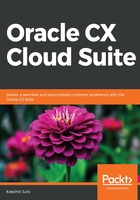
上QQ阅读APP看书,第一时间看更新
Oracle Commerce Cloud
Oracle Commerce Cloud has two main parts for two main use cases: Oracle Commerce for Retail and Oracle Commerce for B2B.
Oracle Commerce for Retail is used for B2C transactions, such as selling products and services to consumers.
Oracle Commerce for B2B, as the name implies, is used for B2B transactions, such as selling products and services to other companies.
The main features are as follows:
- Unified admin
- Platform and APIs
- Responsive storefront
- Guided search
- SEO
- Experience creation
- Loyalty framework
- Content management
- Catalog management
- Promotions
- Multisite management
- Personalization
- Product recommendations
- Transactional emails
- Social wish list and plugins
- B2B and B2C model payments
- Tax agent console
- Assisted selling application
- Adaptive intelligence security
- Integrations
These features enable you to do the following:
- Achieve an optimized UI using drag and drop tools
- Manage site experience
- Use Developer Studio to manage configurations so that the user experience is unified across all devices
- Have simple integrations using APIs
- Use Storefront, which comes with 35 languages and 60 currencies out of the box and can be easily customized and expended to suit your brand's needs
- Use guided search, which enables you to manage and scale search of your store
- Use SEO features to easily optimize for SEO gains using a myriad of in-built functionalities
- Manage your catalog easily, with functionalities to do with products, pricing, and inventory
- Manage B2B customer-specific settings
- Easily manage promotions
- Manage experience based on consumer or customer lifetime, average order value, last purchase amount, number of orders, registration date, first purchase date, last visit date, and more
- Implement experimental and scenario testing for flawless deployments
- Boost engagement with the loyalty framework
- Create non-catalog pages
- Send emails based on site-related activities
- Use social plugins to share your messages and wish lists on social networks
- Use payment gateways by only entering your credentials
- Use one platform to unify your B2B and B2C activities
- Use machine learning and AI to manage your engagement
- Use integrated reports